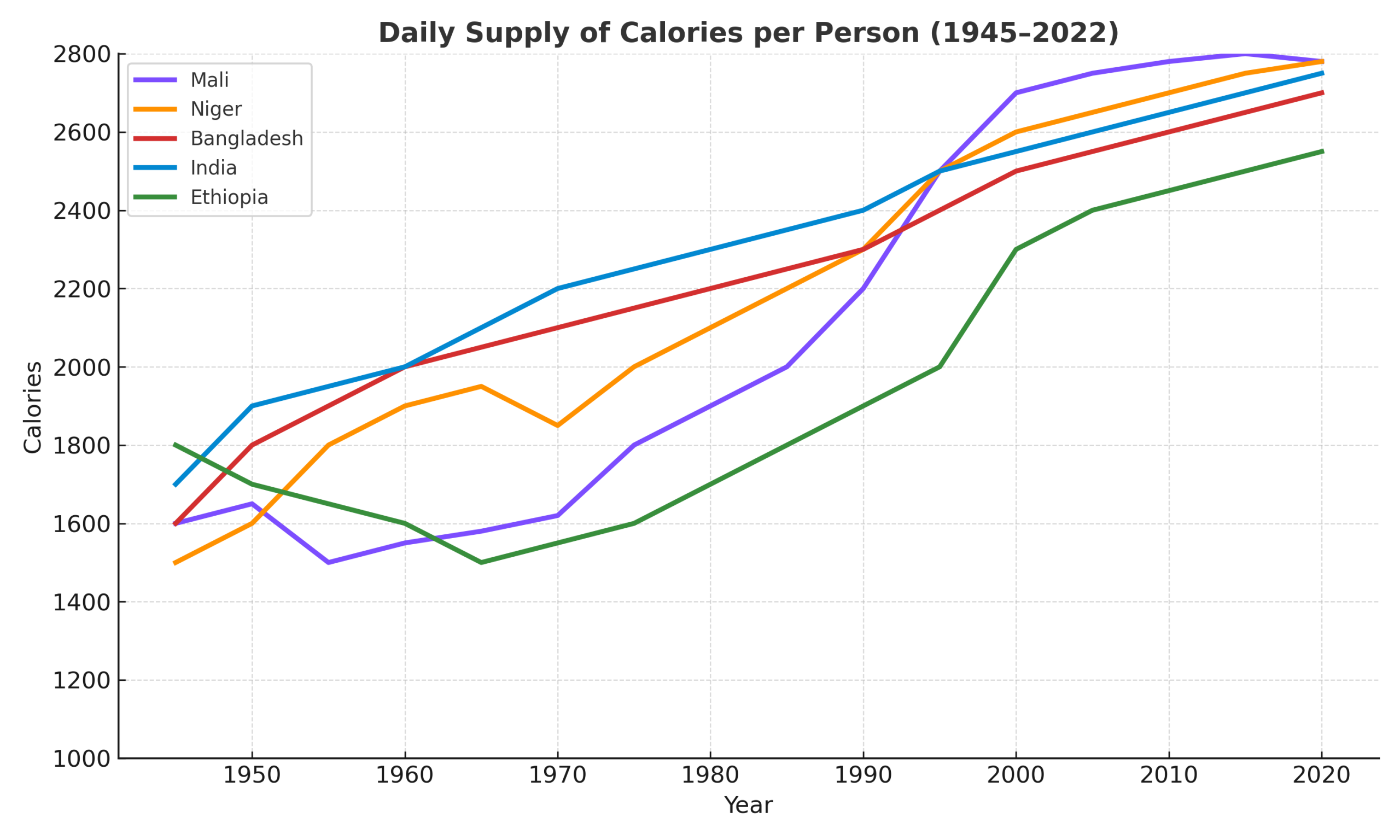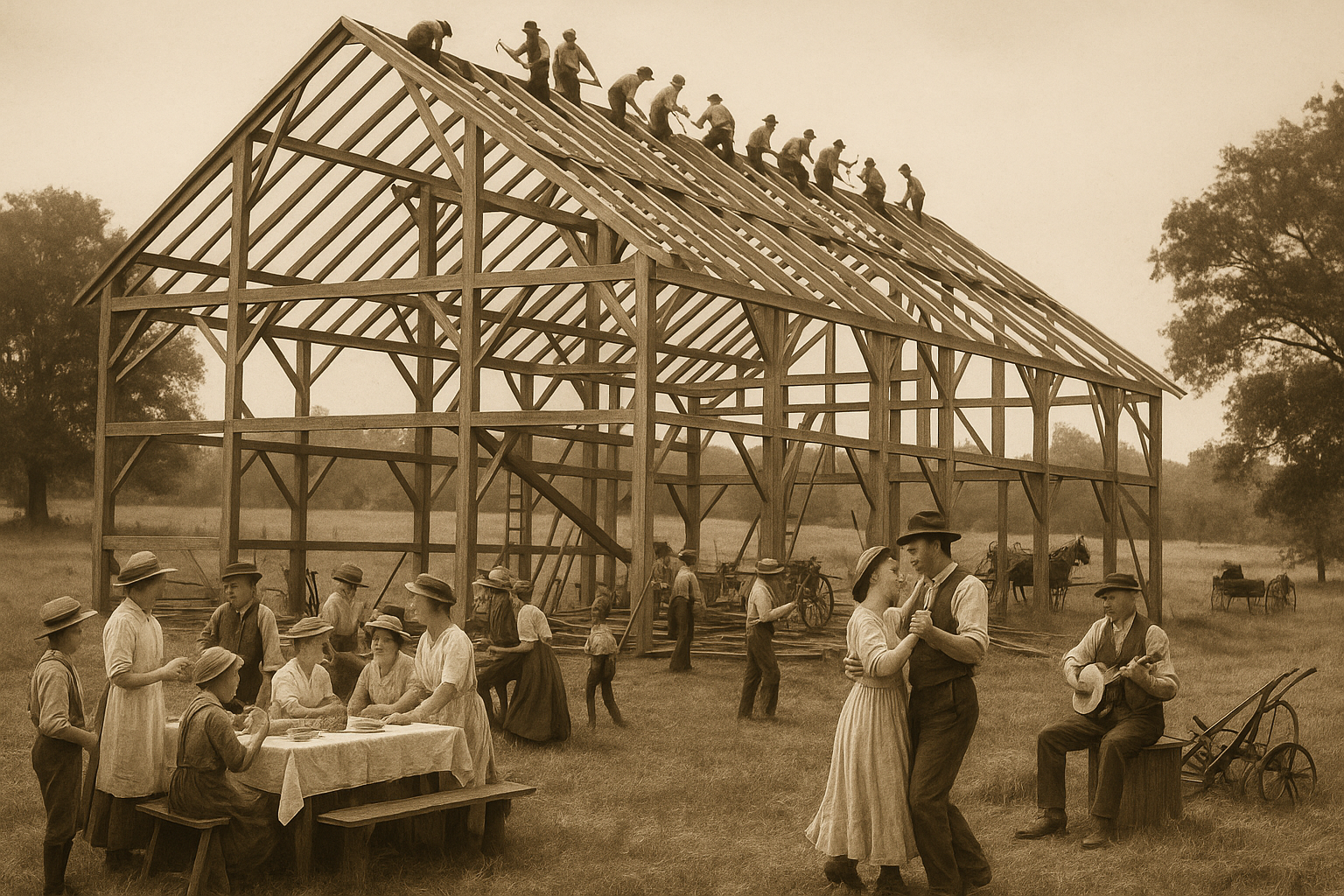There’s a chart making the rounds—bright lines tracking the daily supply of calories from 1945 to 2022 in nations like Ethiopia, Niger, Mali, Bangladesh, and India. Places that once stood as synonyms for starvation. Now? They’re feeding themselves. Not perfectly. Not opulently. But consistently. And the question worth asking is: Why?
The answer, if we have the courage to say it out loud, is this—Americanism did that.
Not the shallow branding of the Stars and Stripes, but the core engine of American greatness: free markets, innovation, private property, and voluntary exchange. In other words: capitalism.
The Seeds of Liberty: How America Exported Abundance
In the ashes of World War II, while much of the world turned to rebuilding, America turned to exporting. Not just goods—but ideas. We built ships that carried not only wheat and tractors, but the philosophical DNA that allowed people to feed themselves: the right to own land, to profit from work, and to use science for human advancement.
Enter Norman Borlaug, the Iowa farm boy turned agricultural scientist who launched the Green Revolution. Through high-yield wheat varieties, synthetic fertilizers, and mechanized farming tools, he helped turn India and Mexico into food producers, not beggars. In fact, by the 1970s, India—once on the brink of mass famine—had become grain self-sufficient. Borlaug’s work, according to some estimates, saved more than a billion lives.
Let that sink in. One man, using the tools of free inquiry and private enterprise, accomplished what no committee of bureaucrats or global summit ever could.
Free Trade and the Freight of Freedom
But Borlaug didn’t work in a vacuum. His innovations took root in a world where American trade routes secured safe passage, where capital investment flowed, and where ideas crossed borders faster than ever before. The United States, through its industrial might and foreign policy, made global trade viable. That mattered for food. When markets open, surplus gets where it’s needed. When nations trade, people eat.
Look at Bangladesh. In the 1970s and ’80s, it was synonymous with famine. But in the 1990s, it began to liberalize its agricultural sector—and food production soared. Similarly, India’s 1991 economic reforms, which rolled back central planning and welcomed private enterprise, triggered one of the most dramatic reductions in poverty ever recorded. Hunger fell as freedom rose.
That’s not coincidence. That’s capitalism doing its job.
The Socialist Mirage: Promises Without Bread
Now the globalists will chime in. They’ll say this was a “cooperative” effort—that international institutions, non-profits, and the global development elite deserve the credit. After all, weren’t they the ones distributing aid? Drafting resolutions? Hosting conferences?
Here’s the truth: you can’t subsidize your way out of starvation. Emergency food aid saves lives in crises—but it doesn’t build sustainable abundance. Only local production, local profit, and local autonomy can do that.
And wherever socialism was tried, the results were tragic. The USSR starved its own people under collectivized farming. Mao’s “Great Leap Forward” killed tens of millions. More recently, Venezuela—rich in oil, poor in freedom—saw supermarket shelves emptied under socialist price controls. Cuba still rations. North Korea still starves. These are not outliers. These are case studies in failure.
Meanwhile, Kenya, Vietnam, and Ghana—countries that embraced market reforms—saw agricultural productivity surge.
So don’t tell me it’s about “equity.” It’s about ownership. It’s about who gets to plant the seed and keep the harvest.
Human Progress, American Roots
Which brings us to today’s chart, sourced from HumanProgress.org. It tracks how daily calorie availability has risen across Ethiopia, Mali, Niger, Bangladesh, and India. In some cases, by more than 800 calories per person per day over just a few decades. That’s not just data. That’s life. That’s the difference between starvation and sustenance, between dependence and dignity.
And yet, no central committee orchestrated this miracle. No socialist five-year plan built this upward curve. The real heroes were farmers, traders, inventors, and entrepreneurs—enabled by American ideas, inspired by American success, and freed from the dead weight of collectivist control.
Conclusion: The Power of Americanism
The world didn’t get fed because bureaucrats passed resolutions. It got fed because capitalists built machines, because scientists pursued profit, and because ordinary people were given the right to work for themselves. That’s Americanism—not as a national brand, but as a moral framework: liberty, productivity, self-determination.
So next time someone tells you capitalism is cruel, point them to this chart. Then ask them which system—really—let the children of Ethiopia, Bangladesh, and Niger go to bed with full stomachs.
Not socialism. Not globalism.
Americanism.
Sources:
- Borlaug, N.E. (1970). Nobel Lecture. https://www.nobelprize.org/prizes/peace/1970/borlaug/lecture/
- HumanProgress.org. (2022). Dataset: Food Supply Per Person Per Day, 1945–2022. https://humanprogress.org/dataset/food-supply-per-person-per-day
- Bhagwati, J. (2004). In Defense of Globalization. Oxford University Press.
- Easterly, W. (2006). The White Man’s Burden. Penguin.
- Heritage Foundation. (2023). “India’s Economic Liberalization and Its Impact on Poverty Reduction.” https://www.heritage.org/
Let me know if you’d like a featured image or Yoast meta description to go with this.



